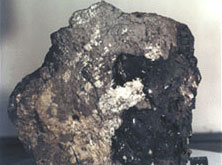A major unresolved debate in lunar studies concerns the early bombardment history of the Moon and the evolution of lunar geological processes through time. Highly shock resistant minerals such as zircon, and uranium-bearing accessory minerals in general, are useful for determining the absolute age and rates of lunar processes, reconstructing planetesimal evolution from trace elements and tracer isotopes, and possibly resolving meteorite provenance(s) with respect to the present and ancient lunar surface. For CLRN members, research into these questions, and others given below, benefits considerably from access to the private meteorite collection of David Gregory, MD (a Western University alumnus). We are currently classifying new achondritic meteorites from this collection and already one new lunar meteorite has been discovered. The interactions of cosmic rays with meteorites and the Moon have been used extensively to study and characterize the exposure ages of these objects and variations in the cosmic ray spectrum in time and space. Many reactions are caused by energetic protons and neutrons (E > 20MeV). The spallation reactions vary with depth, depending on composition and porosity, but most reactions reach a peak at less than 150g /cm². Some reactions between neutrons and target nuclei do not take place until > 200g/cm². These are predicted to reach a maxima between 100–300g/cm².
Neutron capture nuclides have several applications: 1) They are a good measure of the shielding of large objects; 2) concentrations of neutron-produced nuclei can vary substantially and can provide a measure of neutron fluence; 3) the presence of neutron capture products of nuclides affect studies of nuclide systems. For instance, the Sm-Nd isotopic composition may be altered because of unrecognized neutron capture-induced alteration of the Sm isotopic composition in primordial objects. Specific projects for CLRN members include: (1) Studies of Sm isotope variations in chondrites and lunar samples to estimate the primordial Sm isotopic composition, which has a bearing on Sm–Nd isotopic systematics, particularly for 146Sm-induced variations of 142Nd; (2) studies of Gd isotope variations to monitor low energy neutron fluence and to understand the mixing of lunar soils; (3) studies of 146,147Sm–142,143Nd systematics in lunar meteorites to understand their evolution.
Study of the isotopic variations of calcium is also of interest because Ca is important in geochemical and biochemical processes and is a major cation with demonstrated isotopic variability in rocks and minerals. Calcium is critical to life and a major component of the global geochemical cycles that control climate. Radiogenic variations of the major isotope, 40Ca are caused by radioactive decay of 40K. About 89.5% of the 40K decays result in the production of 40Ca; the other 10.5% produce 40Ar and are the basis for the K–Ar and Ar–Ar dating techniques. Rocks and minerals that are a) old and b) rich in potassium can have significant enrichments in 40Ca relative to the other Ca isotopes. The 8-unit spread of isotopic masses also means that there can be significant mass-dependent isotopic fractionation in nature. Consequently there are both radiogenic and thermodynamically generated Ca isotopic variations in terrestrial materials. In meteorites there is also evidence for isotopic effects reflecting incomplete mixing of materials from different nucleosynthetic sources (e.g., 40K can be introduced by late supernova injection), combined with processing in the early solar nebula. As a consequence of radioactive decay, the abundance of 40Ca increases with time in any substance of any mass-dependent isotopic fractionation of Ca isotopes.
The decay of 40K along with U and Th has contributed to Earth’s heat budget which may be the driving force behind mantle convection. If K is sequestered in the core under reducing conditions as predicted by some experiments then it may also influence the heat budget of the core. However the total cosmochemical budget of K for Earth, Moon and Mars is not known very precisely. Using the new state-of-the-art TIMS mass spectrometer, 40Ca isotope variations in lunar samples, terrestrial samples and primitive meteorites are being compared to pin down the K budget for the inner rocky planets.

